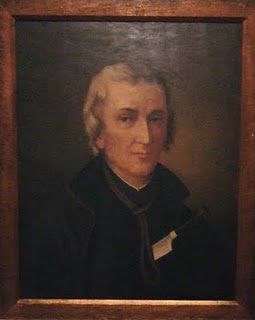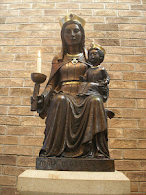
During the dark days of persecution, many, many Catholics remained faithful to the old faith. Up and down the country Catholics of every class risked fines, imprisonment and even death to attend Mass and receive the Sacraments administered by intrepid priests. Amid all this bravery and faithfulness to the Catholic Faith, nowhere was more staunch than Lancashire and Monmouthshire.
David Lewis was a Monmouthshire man, born in Abergavenny in 1616. David was the son of a Catholic mother and a Protestant father and was brought up in the Established Church by his father. As a young man David converted to Catholicism and, after the death of his parents in 1638, he went to Rome to study for the priesthood. Several years after ordination, Fr Lewis entered the Jesuit Novitiate. In 1648 Fr David Lewis, now a professed Jesuit, returned to Wales and the beleaguered Catholics of his homeland. For more than 30 years this selfless priest laboured in the border areas of Monmouthshire and Herefordshire. He ministered to Catholics all over this part of the country but he frequently stayed in the home of Thomas Gunter of Cross Street, Abergavenny. Thomas Gunter was another of the courageous Catholics determined to remain faithful, whatever the cost. He had a secret chapel in the attic of his home and Fr David Lewis and Fr Philip Evans, also a Jesuit, regularly celebrated holy Mass there.
ordination, Fr Lewis entered the Jesuit Novitiate. In 1648 Fr David Lewis, now a professed Jesuit, returned to Wales and the beleaguered Catholics of his homeland. For more than 30 years this selfless priest laboured in the border areas of Monmouthshire and Herefordshire. He ministered to Catholics all over this part of the country but he frequently stayed in the home of Thomas Gunter of Cross Street, Abergavenny. Thomas Gunter was another of the courageous Catholics determined to remain faithful, whatever the cost. He had a secret chapel in the attic of his home and Fr David Lewis and Fr Philip Evans, also a Jesuit, regularly celebrated holy Mass there.
Although both priests were martyred for the faith in 1679 (they were canonised in 1970) the good people of the area somehow remained steadfast in the faith. Attesting to this loyalty, many objects have survived from this distressing period of history. Chief among these treasures must be the Abergavenny Vestments!
The Church of Our Lady and St Michael, Abergavenny, is in possession of a rare and stunning collection of medieval vestments, worn by the priests who ministered to the people of Abergavenny, and kept safe through the years of persecution and beyond. Today these vestments are valued and protected but are displayed to the public occasionally and sometimes worn on very special occasions.
On 17th September 2011, we had the very great privilege of viewing the medieval vestments. They were displayed in the church that day and the parish priest, Dom Thomas Regan, O S B, was on hand to greet visitors and explain the history and function of the vestments. Fr Regan is extremely knowledgeable regarding Catholic history and his exuberant descriptions of the vestments were peppered with interesting and amazing snippets of information.
David Lewis was a Monmouthshire man, born in Abergavenny in 1616. David was the son of a Catholic mother and a Protestant father and was brought up in the Established Church by his father. As a young man David converted to Catholicism and, after the death of his parents in 1638, he went to Rome to study for the priesthood. Several years after
 ordination, Fr Lewis entered the Jesuit Novitiate. In 1648 Fr David Lewis, now a professed Jesuit, returned to Wales and the beleaguered Catholics of his homeland. For more than 30 years this selfless priest laboured in the border areas of Monmouthshire and Herefordshire. He ministered to Catholics all over this part of the country but he frequently stayed in the home of Thomas Gunter of Cross Street, Abergavenny. Thomas Gunter was another of the courageous Catholics determined to remain faithful, whatever the cost. He had a secret chapel in the attic of his home and Fr David Lewis and Fr Philip Evans, also a Jesuit, regularly celebrated holy Mass there.
ordination, Fr Lewis entered the Jesuit Novitiate. In 1648 Fr David Lewis, now a professed Jesuit, returned to Wales and the beleaguered Catholics of his homeland. For more than 30 years this selfless priest laboured in the border areas of Monmouthshire and Herefordshire. He ministered to Catholics all over this part of the country but he frequently stayed in the home of Thomas Gunter of Cross Street, Abergavenny. Thomas Gunter was another of the courageous Catholics determined to remain faithful, whatever the cost. He had a secret chapel in the attic of his home and Fr David Lewis and Fr Philip Evans, also a Jesuit, regularly celebrated holy Mass there.Although both priests were martyred for the faith in 1679 (they were canonised in 1970) the good people of the area somehow remained steadfast in the faith. Attesting to this loyalty, many objects have survived from this distressing period of history. Chief among these treasures must be the Abergavenny Vestments!
The Church of Our Lady and St Michael, Abergavenny, is in possession of a rare and stunning collection of medieval vestments, worn by the priests who ministered to the people of Abergavenny, and kept safe through the years of persecution and beyond. Today these vestments are valued and protected but are displayed to the public occasionally and sometimes worn on very special occasions.
On 17th September 2011, we had the very great privilege of viewing the medieval vestments. They were displayed in the church that day and the parish priest, Dom Thomas Regan, O S B, was on hand to greet visitors and explain the history and function of the vestments. Fr Regan is extremely knowledgeable regarding Catholic history and his exuberant descriptions of the vestments were peppered with interesting and amazing snippets of information.

Perhaps the most beautiful and most valuable vestment on display was the red chasuble made at the Court of King Henry VII in 1498. It was given as a gift to Abergavenny Church by Henry’s wife, Elizabeth of York. My personal favourite though was the unusual brown chasuble. Father said that this was made about 1500 and is believed to have been made locally. A white chasuble (circa 1505), thought to have its origins in Crickhowell, and a gold chasuble (1521) were also on show.
 Completing the display was a beautiful cope. The cope itself is modern but the embroidery is original and from the time of Henry VII. The embroidery was recovered from an ancient cope that had not stood the test of time.
Completing the display was a beautiful cope. The cope itself is modern but the embroidery is original and from the time of Henry VII. The embroidery was recovered from an ancient cope that had not stood the test of time.  While these vestments form a very important part of our Catholic history, they are also an important part of the history of Monmouthshire in general and Abergavenny in particular. We are indebted to the Catholics who have safeguarded them through the centuries. We also owe a debt of gratitude to the parishioners of Our Lady and St Michael and to Dom Thomas Regan for the continued preservation and protection of these cherished relics.
While these vestments form a very important part of our Catholic history, they are also an important part of the history of Monmouthshire in general and Abergavenny in particular. We are indebted to the Catholics who have safeguarded them through the centuries. We also owe a debt of gratitude to the parishioners of Our Lady and St Michael and to Dom Thomas Regan for the continued preservation and protection of these cherished relics. 









.JPG)

.JPG)



.JPG)

